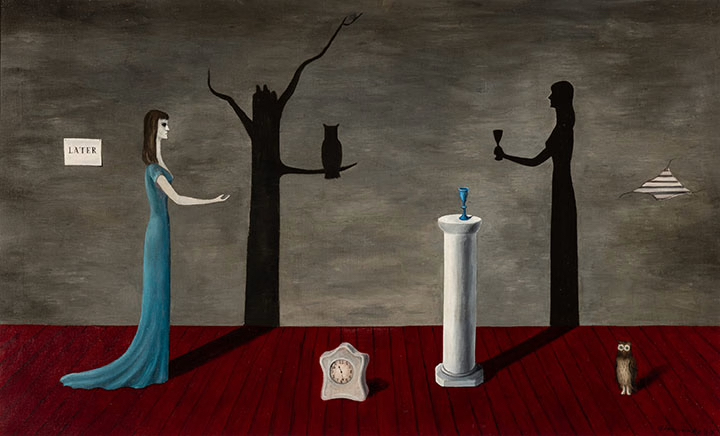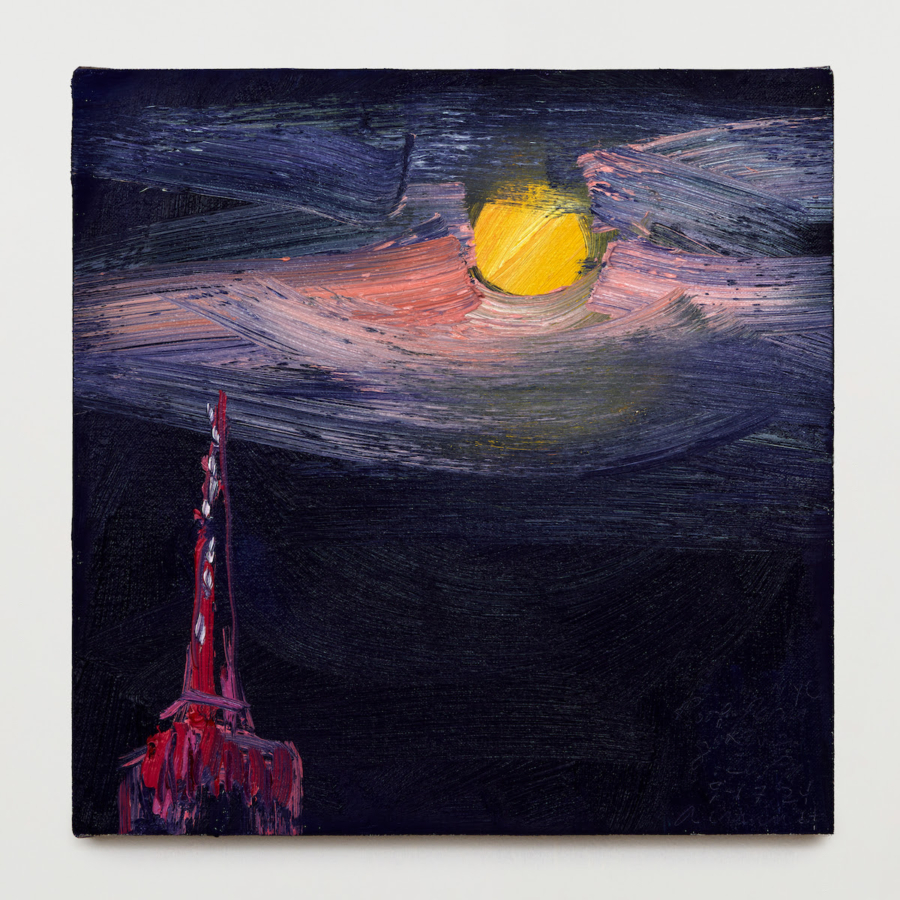
March 15, 2025
“Incongruity is the secret to art,” said the Chicago Surrealist painter Gertrude Abercrombie (1909-1977)—and she gave herself plenty of discrepant ingredients to work with: “doors, moons, barren trees and stumps, seashells, masked and shrouded figures, towers and pyramids, clouds, dominoes and jacks, stairs, eggs, couches, letters, and ladders.” That inventory is courtesy of Eric Crosby, director of the Carnegie Museum of Art, where a retrospective exhibition, “Gertrude Abercrombie: The Whole World Is a Mystery,” is on view through June 1 before traveling to the Colby College Museum of Art in Waterville, Maine. Curated by Mr. Crosby and Colby’s Sarah Humphreville, it’s an oddly substantial exhibition—with a genuine keeper of a catalog—even though its contents are small, often tiny paintings (all displayed under spotlights in two long corridors painted varying shades of light chocolate brown).
Abercrombie was born in Austin, Texas, to itinerant and impoverished opera singers who eventually retreated to family turf in Illinois. She attended the University of Illinois, obtaining a degree in Romance languages, but also took every art class that she could. For four years in the early 1930s, Abercrombie was the house commercial artist for a few Chicago department stores. In 1935, however, she was able to pursue fine art full-time via a grant from the Works Progress Administration: In return for producing a monthly easel painting, she received $94. (Her live-in studio was only $11 a month, including utilities.)
Abercrombie quickly became successful in a city where artistic quirkiness—with the dark Magic Realism of Ivan Albright, the Monster Roster of Leon Golub and a few others, and such Chicago Imagists as the Hairy Who—made for a kind of municipal uber-style that continues to some extent today. She joined Katharine Kuh’s influential Chicago gallery, had a painting in the 1939 World’s Fair in New York, and was generally praised by critics; this commercial and critical success extended through the ’40s and into the 1950s.
Her personal life was another matter. An alcoholic, she was twice divorced and had little apparent interest in raising her one child, a daughter. As was negatively noted even during her lifetime, she also enjoyed a surfeit of sexual partners. Abercrombie played the piano fairly well and, as a jazz aficionada, hosted parties with Charlie Parker, Dizzy Gillespie and others. Although some of Abercrombie’s painting titles are inspired by standards—“How High the Moon,” “Somebody Loves Me,” “Where or When”—she did not “hold music to be a model for abstraction or jazz to be a distinct national product.” By the mid-1960s, however, she was an emotional wreck with an assortment of physical ailments, completely broke (she lost her savings to a fraudster), and in artistic decline.
When she was good, Abercrombie was a quietly and weirdly charming artist. “White Cat” (1938) is a deceptively simple and almost faux faux-naïf painting: a simple white room with a gray door and wainscoting, a dark floor on which sits a low brown table with a blue vase and, in a corner, a white cat. On the wall is a painting of a bleak landscape containing the leafless remnant of a tree, and a female figure—likely Abercrombie herself—walking a small white dog. (The door reappears in later work as the main subject.) What does it all mean? Certainly it evokes loneliness and a feeling of being the odd woman out, but it also marks an attempt to create an American Surrealism full of spooky normalcy.
Abercrombie’s work contains several self-portraits, a particularly good one being “Self-Portrait, the Striped Blouse” (1940). At 36 by 30 inches, it’s one of the larger paintings in the show, and somehow one of the scariest. A severe-looking Abercrombie, wearing a flat brimmed black hat and a wonderfully painted black-and-white striped blouse (both the boldness of the pattern and the modeling of it as worn are spot on), reaches a claw-like hand into a compote dish of grapes. Outside the window behind her is a stunted tree and an ominous sky.
In the late 1950s, Abercrombie began painting rows of doors much like the one in “White Cat,” save that they’re typically colored red, white and blue-green—and somehow standing on a sidewalk with no visible support. “Doors, 4 (5½)” (1957) is the best of them (the cats in a couple of others have a whiff of Hallmark cuteness). The rendering is flat and simplified—each door has the same inset panels with white highlighted borders and dark gray shadowed ones. On rather thin evidence (Abercrombie didn’t like what she considered the heartless urban renewal taking place adjacent to her), the paintings are purported by some to be protest pictures. One of the better of her typically small late paintings is “Untitled (Tree at Aledo Variation)” (1963): a leafless white specimen with odd (to put it mildly) black branches—almost stubs—growing out of it. The tree stands, seemingly rootless, on a flat floor plane against a gloomy sky with a single, desultory white cloud floating low, near the horizon. Its economy, simplicity and lack of any earthly life make for a haunting picture.
Because they’re comparatively small and decidedly unflashy, Abercrombie’s pictures require a bit of careful—and sympathetic—looking to appreciate their strangeness and originality. The paintings’ lack of technical flair is probably what led the artist to say, “I don’t think I’m a very good painter but I do think I’m a good artist.” Actually, in her peculiar way, Gertrude Abercrombie was very much both.


